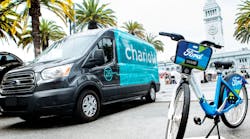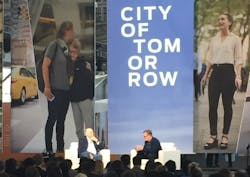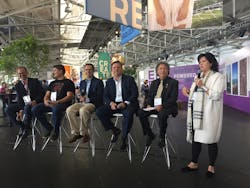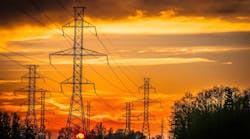On Aug. 17, I attended an event called City of Tomorrow in San Francisco hosted by Ford because I was curious about a panel about what the new world of “mobility” will do to the aging grid (their words). First, I was struck by how low-key Ford was about self-promotion. There wasn’t a single vehicle on display, or even mentioned. The only overt Ford mobility (you are going to hear this word a lot) presence was Ford rental gobikes outside the venue and the on-demand mini buses we see all over San Francisco called Chariots, which Ford recently acquired. Again, it’s all about mobility:
The event covered all forms of change happening in the urban core, including autonomous vehicles, road design, public transportation and of most interest to me: EVs and the grid. Ford has an internal group called Smart Mobility that is looking at how we are all going to get around in the next 50 years in a world of Lyft, Uber, EVs and self-driving vehicles.
Jim Hackett, Ford’s president and CEO, talked about technology in front of a crowd of about 1000 people and made a strong case for a radical change in thinking about why we own cars and trucks at all if they are only being used for an hour a day.
Jim Hackett, Ford's president, is interviewed by Alex McDowell, the creative director at the USC World Building Institute
So while this is all very interesting, what does this mean for those of us working on the grid? James Ehrlich, an entrepreneur in residence at Stanford University, moderated a panel on the new urban grid and there were some interesting takeaways.
James Ehrlich kicked off by asking everyone to define the grid and the consensus was that it is the world’s oldest network but it’s changing rapidly because of renewables and distributed energy resources. But it’s also the network of the future because if we move to EVs, then there are plugs everywhere, literally. Someone quipped that if the EV revolution occurs, then what are we going to do with all the abandoned gas stations? Matt Petersen from LA Cleantech noted that if the universal mobility idea takes hold, we should also ask the same question about parking lots and garages (remember you won’t own a car, you will just share).
Left to right: Matt Petersen from the LA CleanTech incubator, Justin Calmus from HackerOne, Austin Ashe from GE Intelligent Cities, Steve Malnight from Pacific Gas & Electric, the aforementioned James Ehrlich. They were all introduced by Sheryl Connelly of Ford Global Trends.
Austin Ashe from GE pointed out that there are over 80,000 street lights in San Francisco (owned by PG&E and part of the grid) that need to be maintained but they are also an opportunity for a company like GE to add sensors, charging and connectivity to. The old network can become the new network if the right vision is applied.
Steve Malnight from PG&E noted that parked EVs can become part of the new 2-way grid and can be backup for the grid in case there is another solar eclipse in the United States (and there will be in 2024). Interestingly Malnight estimates that an EV is the equivalent of half a household of power consumption so a 2-car family effectively doubles the load and therefore the revenue potential for a utility like PG&E. With 20% of all the EVs in the United States in California, this is a very acute and looming opportunity (or threat) for PG&E, so it was refreshing to see the utility accepting the changes happening around them and deciding to work with the market rather than against it.
James Ehrlich then posed the question on many utility professionals’ minds right now and that’s security. Justin Calmus from HackerOne had done some homework on vulnerable utility networks and provocatively stated that there are hundreds of exposed networks out there today. This is an area where the Internet of Things (IoT) collides with the industrial world of utilities, which have lived for years with their own private SCADA networks. My theory is that one of the main reasons why utilities rarely talk about the IoT is they have had it for years, well before consumers started connecting their NEST thermostats and door bells. My background is in the electronics industry so I had inkling about what he was talking about and actually blogged about this issue of unprotected networks earlier this year. Justin is a “white hat” hacker so he may have his own tools, but there is a search engine for network routers called Shodan that will show you in just a few clicks which industrial networks are unprotected by their protocol and location. At this point I don’t want to encourage bad behavior so won’t list all of the gory details, but when I asked Justin why so many networks are left unsecured he was very clear; it’s an education problem. Never connect a router of device without changing the default password (be honest, have you done this?) and always apply updates to your hardware when they are needed (again, many users don’t patch their systems). To me this is a huge issue, and we will be working with the Utility Analytics Institute to educate the 3,000+ power utilities in the United States to protect themselves.
Ehrlich closed by posing the blue sky question to everyone about where the grid is heading, and the panel was upbeat about the opportunity to reduce greenhouse emissions and change cities and society for the better. The largest oil and gas companies in the world (Saudi Aramco, China Petroleum, Exxon, Shell, BP, Total, Lukoil etc..) are having to face an existential moment, but it’s also an opportunity for our industry to change the world; really.




